Project Execution Planning and Management for NSW M4 Motorway Expansion
VerifiedAdded on 2023/06/14
|8
|2483
|255
AI Summary
This report details the best project delivery, financial contracting, and procurement methods for the NSW M4 motorway expansion project. The evaluation matrix is based on project goals and challenges, and recommends CM@Risk project delivery method, GMP financial contracting, and best value procurement.
Contribute Materials
Your contribution can guide someone’s learning journey. Share your
documents today.
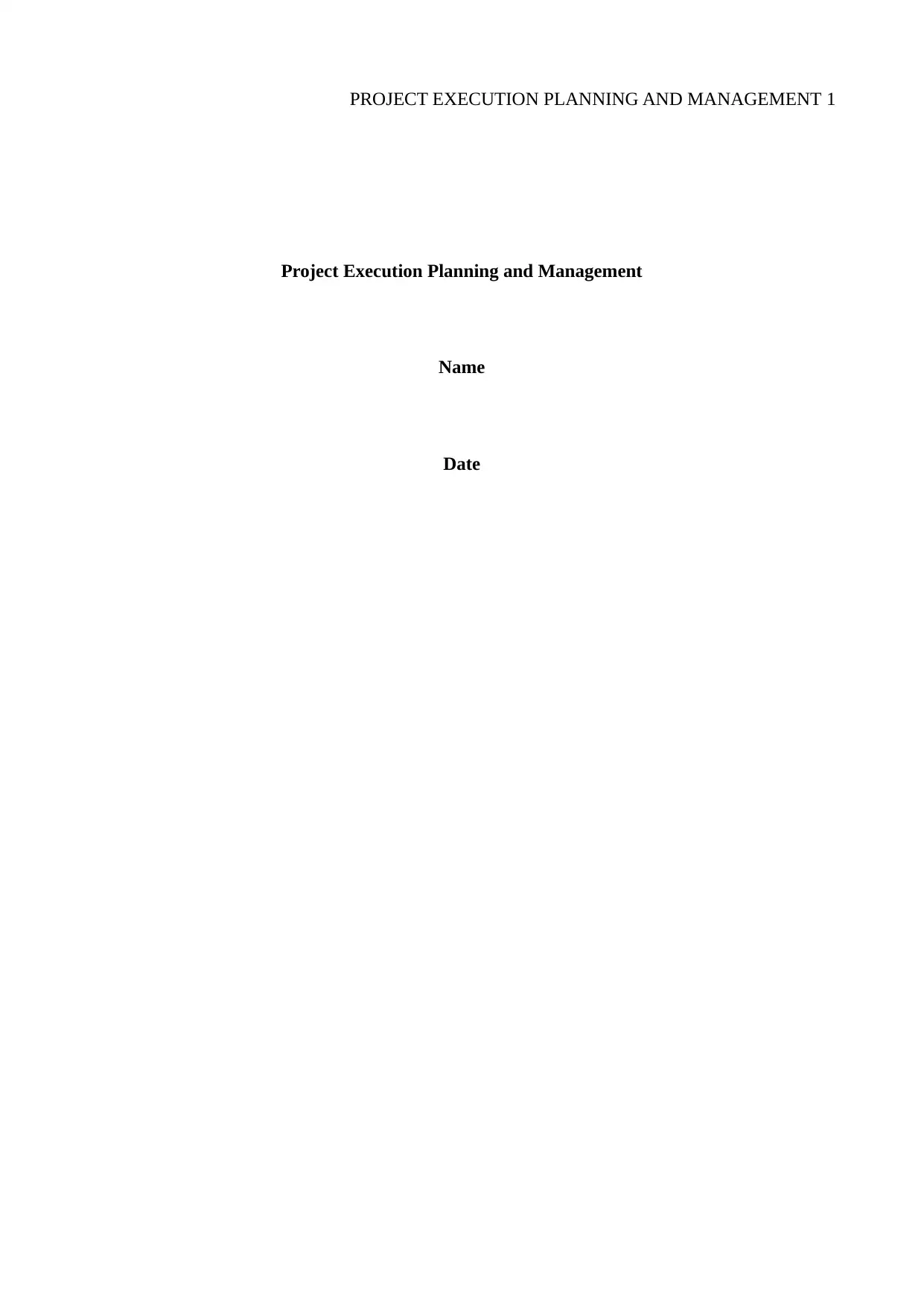
PROJECT EXECUTION PLANNING AND MANAGEMENT 1
Project Execution Planning and Management
Name
Date
Project Execution Planning and Management
Name
Date
Secure Best Marks with AI Grader
Need help grading? Try our AI Grader for instant feedback on your assignments.
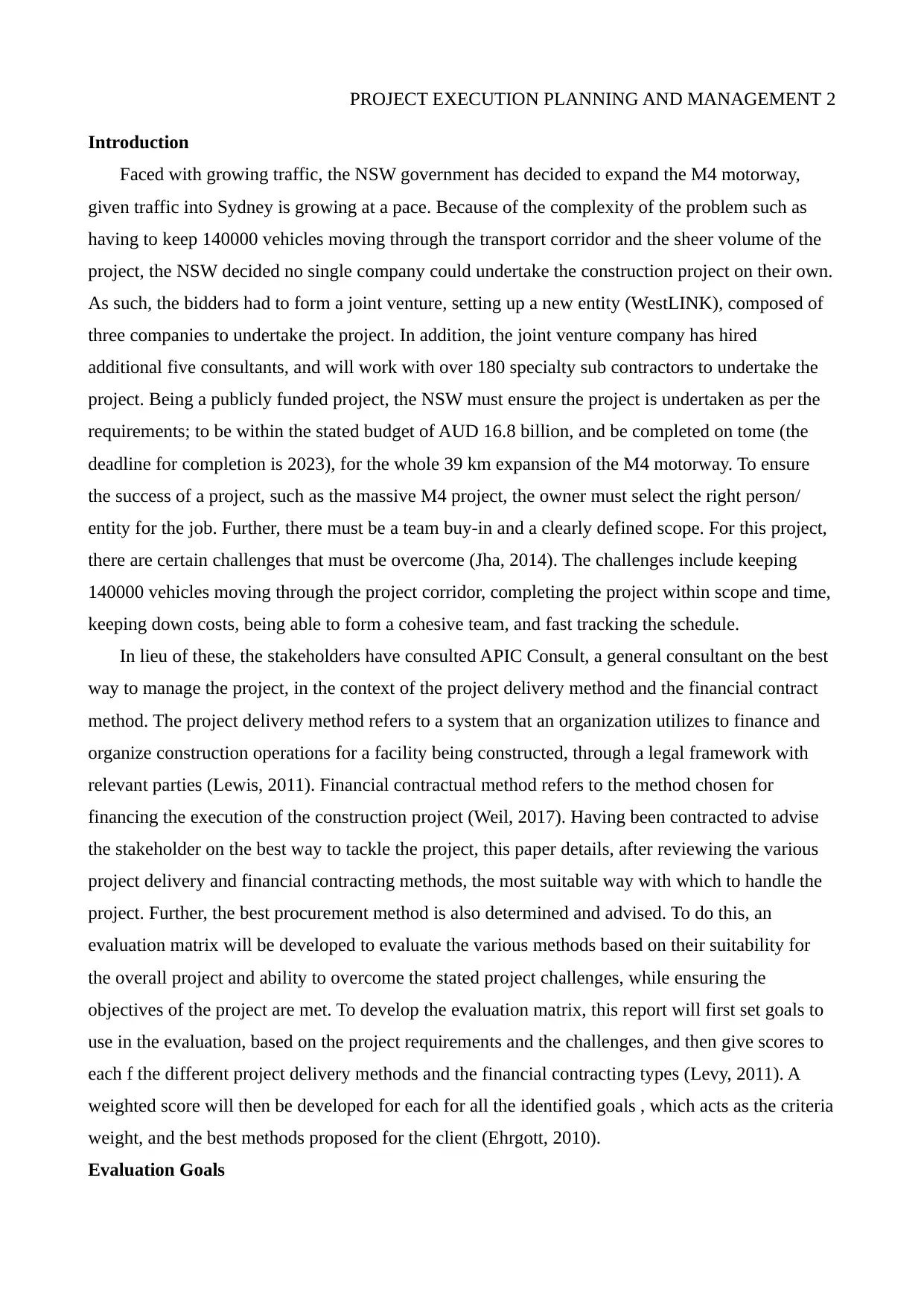
PROJECT EXECUTION PLANNING AND MANAGEMENT 2
Introduction
Faced with growing traffic, the NSW government has decided to expand the M4 motorway,
given traffic into Sydney is growing at a pace. Because of the complexity of the problem such as
having to keep 140000 vehicles moving through the transport corridor and the sheer volume of the
project, the NSW decided no single company could undertake the construction project on their own.
As such, the bidders had to form a joint venture, setting up a new entity (WestLINK), composed of
three companies to undertake the project. In addition, the joint venture company has hired
additional five consultants, and will work with over 180 specialty sub contractors to undertake the
project. Being a publicly funded project, the NSW must ensure the project is undertaken as per the
requirements; to be within the stated budget of AUD 16.8 billion, and be completed on tome (the
deadline for completion is 2023), for the whole 39 km expansion of the M4 motorway. To ensure
the success of a project, such as the massive M4 project, the owner must select the right person/
entity for the job. Further, there must be a team buy-in and a clearly defined scope. For this project,
there are certain challenges that must be overcome (Jha, 2014). The challenges include keeping
140000 vehicles moving through the project corridor, completing the project within scope and time,
keeping down costs, being able to form a cohesive team, and fast tracking the schedule.
In lieu of these, the stakeholders have consulted APIC Consult, a general consultant on the best
way to manage the project, in the context of the project delivery method and the financial contract
method. The project delivery method refers to a system that an organization utilizes to finance and
organize construction operations for a facility being constructed, through a legal framework with
relevant parties (Lewis, 2011). Financial contractual method refers to the method chosen for
financing the execution of the construction project (Weil, 2017). Having been contracted to advise
the stakeholder on the best way to tackle the project, this paper details, after reviewing the various
project delivery and financial contracting methods, the most suitable way with which to handle the
project. Further, the best procurement method is also determined and advised. To do this, an
evaluation matrix will be developed to evaluate the various methods based on their suitability for
the overall project and ability to overcome the stated project challenges, while ensuring the
objectives of the project are met. To develop the evaluation matrix, this report will first set goals to
use in the evaluation, based on the project requirements and the challenges, and then give scores to
each f the different project delivery methods and the financial contracting types (Levy, 2011). A
weighted score will then be developed for each for all the identified goals , which acts as the criteria
weight, and the best methods proposed for the client (Ehrgott, 2010).
Evaluation Goals
Introduction
Faced with growing traffic, the NSW government has decided to expand the M4 motorway,
given traffic into Sydney is growing at a pace. Because of the complexity of the problem such as
having to keep 140000 vehicles moving through the transport corridor and the sheer volume of the
project, the NSW decided no single company could undertake the construction project on their own.
As such, the bidders had to form a joint venture, setting up a new entity (WestLINK), composed of
three companies to undertake the project. In addition, the joint venture company has hired
additional five consultants, and will work with over 180 specialty sub contractors to undertake the
project. Being a publicly funded project, the NSW must ensure the project is undertaken as per the
requirements; to be within the stated budget of AUD 16.8 billion, and be completed on tome (the
deadline for completion is 2023), for the whole 39 km expansion of the M4 motorway. To ensure
the success of a project, such as the massive M4 project, the owner must select the right person/
entity for the job. Further, there must be a team buy-in and a clearly defined scope. For this project,
there are certain challenges that must be overcome (Jha, 2014). The challenges include keeping
140000 vehicles moving through the project corridor, completing the project within scope and time,
keeping down costs, being able to form a cohesive team, and fast tracking the schedule.
In lieu of these, the stakeholders have consulted APIC Consult, a general consultant on the best
way to manage the project, in the context of the project delivery method and the financial contract
method. The project delivery method refers to a system that an organization utilizes to finance and
organize construction operations for a facility being constructed, through a legal framework with
relevant parties (Lewis, 2011). Financial contractual method refers to the method chosen for
financing the execution of the construction project (Weil, 2017). Having been contracted to advise
the stakeholder on the best way to tackle the project, this paper details, after reviewing the various
project delivery and financial contracting methods, the most suitable way with which to handle the
project. Further, the best procurement method is also determined and advised. To do this, an
evaluation matrix will be developed to evaluate the various methods based on their suitability for
the overall project and ability to overcome the stated project challenges, while ensuring the
objectives of the project are met. To develop the evaluation matrix, this report will first set goals to
use in the evaluation, based on the project requirements and the challenges, and then give scores to
each f the different project delivery methods and the financial contracting types (Levy, 2011). A
weighted score will then be developed for each for all the identified goals , which acts as the criteria
weight, and the best methods proposed for the client (Ehrgott, 2010).
Evaluation Goals
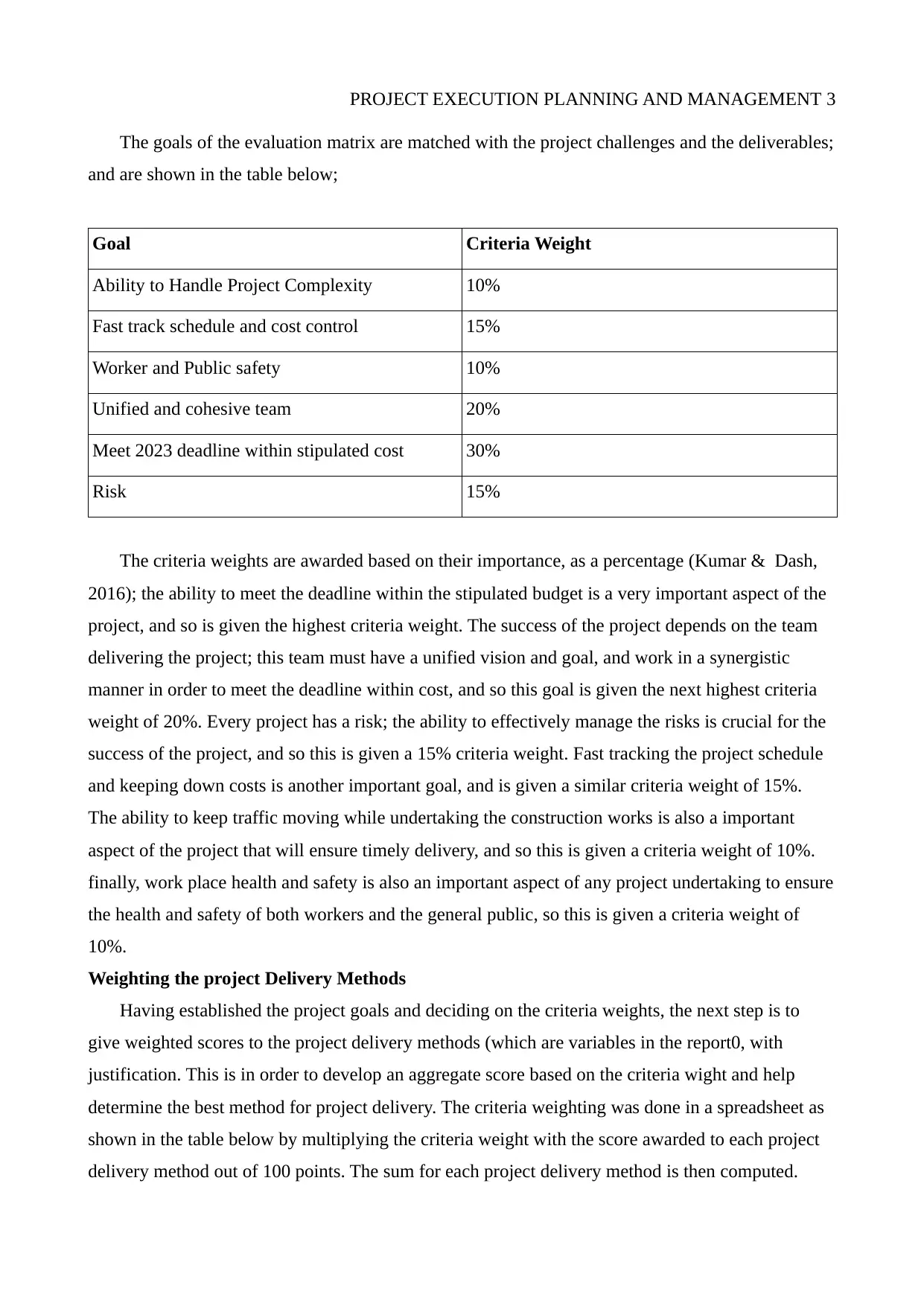
PROJECT EXECUTION PLANNING AND MANAGEMENT 3
The goals of the evaluation matrix are matched with the project challenges and the deliverables;
and are shown in the table below;
Goal Criteria Weight
Ability to Handle Project Complexity 10%
Fast track schedule and cost control 15%
Worker and Public safety 10%
Unified and cohesive team 20%
Meet 2023 deadline within stipulated cost 30%
Risk 15%
The criteria weights are awarded based on their importance, as a percentage (Kumar & Dash,
2016); the ability to meet the deadline within the stipulated budget is a very important aspect of the
project, and so is given the highest criteria weight. The success of the project depends on the team
delivering the project; this team must have a unified vision and goal, and work in a synergistic
manner in order to meet the deadline within cost, and so this goal is given the next highest criteria
weight of 20%. Every project has a risk; the ability to effectively manage the risks is crucial for the
success of the project, and so this is given a 15% criteria weight. Fast tracking the project schedule
and keeping down costs is another important goal, and is given a similar criteria weight of 15%.
The ability to keep traffic moving while undertaking the construction works is also a important
aspect of the project that will ensure timely delivery, and so this is given a criteria weight of 10%.
finally, work place health and safety is also an important aspect of any project undertaking to ensure
the health and safety of both workers and the general public, so this is given a criteria weight of
10%.
Weighting the project Delivery Methods
Having established the project goals and deciding on the criteria weights, the next step is to
give weighted scores to the project delivery methods (which are variables in the report0, with
justification. This is in order to develop an aggregate score based on the criteria wight and help
determine the best method for project delivery. The criteria weighting was done in a spreadsheet as
shown in the table below by multiplying the criteria weight with the score awarded to each project
delivery method out of 100 points. The sum for each project delivery method is then computed.
The goals of the evaluation matrix are matched with the project challenges and the deliverables;
and are shown in the table below;
Goal Criteria Weight
Ability to Handle Project Complexity 10%
Fast track schedule and cost control 15%
Worker and Public safety 10%
Unified and cohesive team 20%
Meet 2023 deadline within stipulated cost 30%
Risk 15%
The criteria weights are awarded based on their importance, as a percentage (Kumar & Dash,
2016); the ability to meet the deadline within the stipulated budget is a very important aspect of the
project, and so is given the highest criteria weight. The success of the project depends on the team
delivering the project; this team must have a unified vision and goal, and work in a synergistic
manner in order to meet the deadline within cost, and so this goal is given the next highest criteria
weight of 20%. Every project has a risk; the ability to effectively manage the risks is crucial for the
success of the project, and so this is given a 15% criteria weight. Fast tracking the project schedule
and keeping down costs is another important goal, and is given a similar criteria weight of 15%.
The ability to keep traffic moving while undertaking the construction works is also a important
aspect of the project that will ensure timely delivery, and so this is given a criteria weight of 10%.
finally, work place health and safety is also an important aspect of any project undertaking to ensure
the health and safety of both workers and the general public, so this is given a criteria weight of
10%.
Weighting the project Delivery Methods
Having established the project goals and deciding on the criteria weights, the next step is to
give weighted scores to the project delivery methods (which are variables in the report0, with
justification. This is in order to develop an aggregate score based on the criteria wight and help
determine the best method for project delivery. The criteria weighting was done in a spreadsheet as
shown in the table below by multiplying the criteria weight with the score awarded to each project
delivery method out of 100 points. The sum for each project delivery method is then computed.
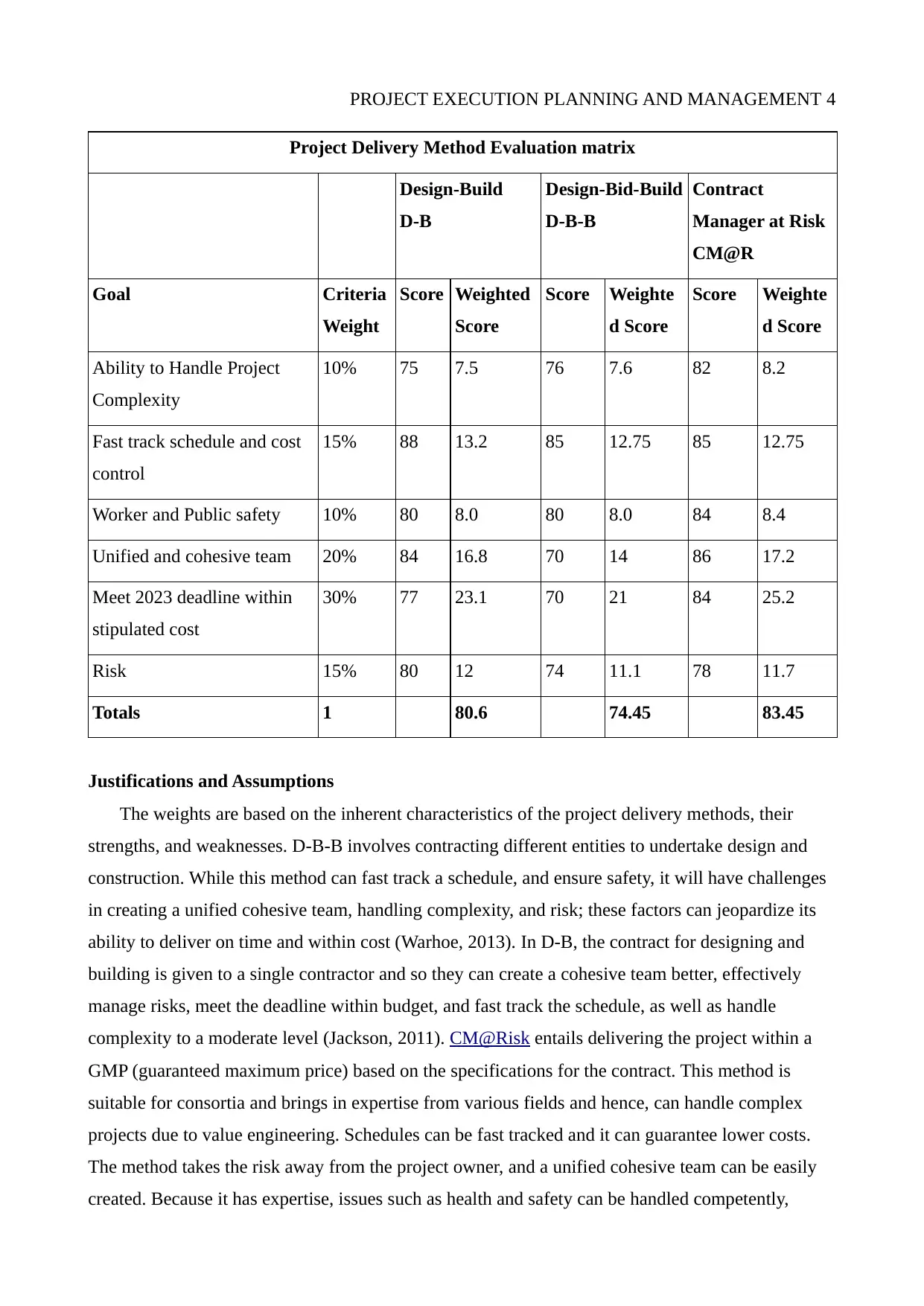
PROJECT EXECUTION PLANNING AND MANAGEMENT 4
Project Delivery Method Evaluation matrix
Design-Build
D-B
Design-Bid-Build
D-B-B
Contract
Manager at Risk
CM@R
Goal Criteria
Weight
Score Weighted
Score
Score Weighte
d Score
Score Weighte
d Score
Ability to Handle Project
Complexity
10% 75 7.5 76 7.6 82 8.2
Fast track schedule and cost
control
15% 88 13.2 85 12.75 85 12.75
Worker and Public safety 10% 80 8.0 80 8.0 84 8.4
Unified and cohesive team 20% 84 16.8 70 14 86 17.2
Meet 2023 deadline within
stipulated cost
30% 77 23.1 70 21 84 25.2
Risk 15% 80 12 74 11.1 78 11.7
Totals 1 80.6 74.45 83.45
Justifications and Assumptions
The weights are based on the inherent characteristics of the project delivery methods, their
strengths, and weaknesses. D-B-B involves contracting different entities to undertake design and
construction. While this method can fast track a schedule, and ensure safety, it will have challenges
in creating a unified cohesive team, handling complexity, and risk; these factors can jeopardize its
ability to deliver on time and within cost (Warhoe, 2013). In D-B, the contract for designing and
building is given to a single contractor and so they can create a cohesive team better, effectively
manage risks, meet the deadline within budget, and fast track the schedule, as well as handle
complexity to a moderate level (Jackson, 2011). CM@Risk entails delivering the project within a
GMP (guaranteed maximum price) based on the specifications for the contract. This method is
suitable for consortia and brings in expertise from various fields and hence, can handle complex
projects due to value engineering. Schedules can be fast tracked and it can guarantee lower costs.
The method takes the risk away from the project owner, and a unified cohesive team can be easily
created. Because it has expertise, issues such as health and safety can be handled competently,
Project Delivery Method Evaluation matrix
Design-Build
D-B
Design-Bid-Build
D-B-B
Contract
Manager at Risk
CM@R
Goal Criteria
Weight
Score Weighted
Score
Score Weighte
d Score
Score Weighte
d Score
Ability to Handle Project
Complexity
10% 75 7.5 76 7.6 82 8.2
Fast track schedule and cost
control
15% 88 13.2 85 12.75 85 12.75
Worker and Public safety 10% 80 8.0 80 8.0 84 8.4
Unified and cohesive team 20% 84 16.8 70 14 86 17.2
Meet 2023 deadline within
stipulated cost
30% 77 23.1 70 21 84 25.2
Risk 15% 80 12 74 11.1 78 11.7
Totals 1 80.6 74.45 83.45
Justifications and Assumptions
The weights are based on the inherent characteristics of the project delivery methods, their
strengths, and weaknesses. D-B-B involves contracting different entities to undertake design and
construction. While this method can fast track a schedule, and ensure safety, it will have challenges
in creating a unified cohesive team, handling complexity, and risk; these factors can jeopardize its
ability to deliver on time and within cost (Warhoe, 2013). In D-B, the contract for designing and
building is given to a single contractor and so they can create a cohesive team better, effectively
manage risks, meet the deadline within budget, and fast track the schedule, as well as handle
complexity to a moderate level (Jackson, 2011). CM@Risk entails delivering the project within a
GMP (guaranteed maximum price) based on the specifications for the contract. This method is
suitable for consortia and brings in expertise from various fields and hence, can handle complex
projects due to value engineering. Schedules can be fast tracked and it can guarantee lower costs.
The method takes the risk away from the project owner, and a unified cohesive team can be easily
created. Because it has expertise, issues such as health and safety can be handled competently,
Secure Best Marks with AI Grader
Need help grading? Try our AI Grader for instant feedback on your assignments.
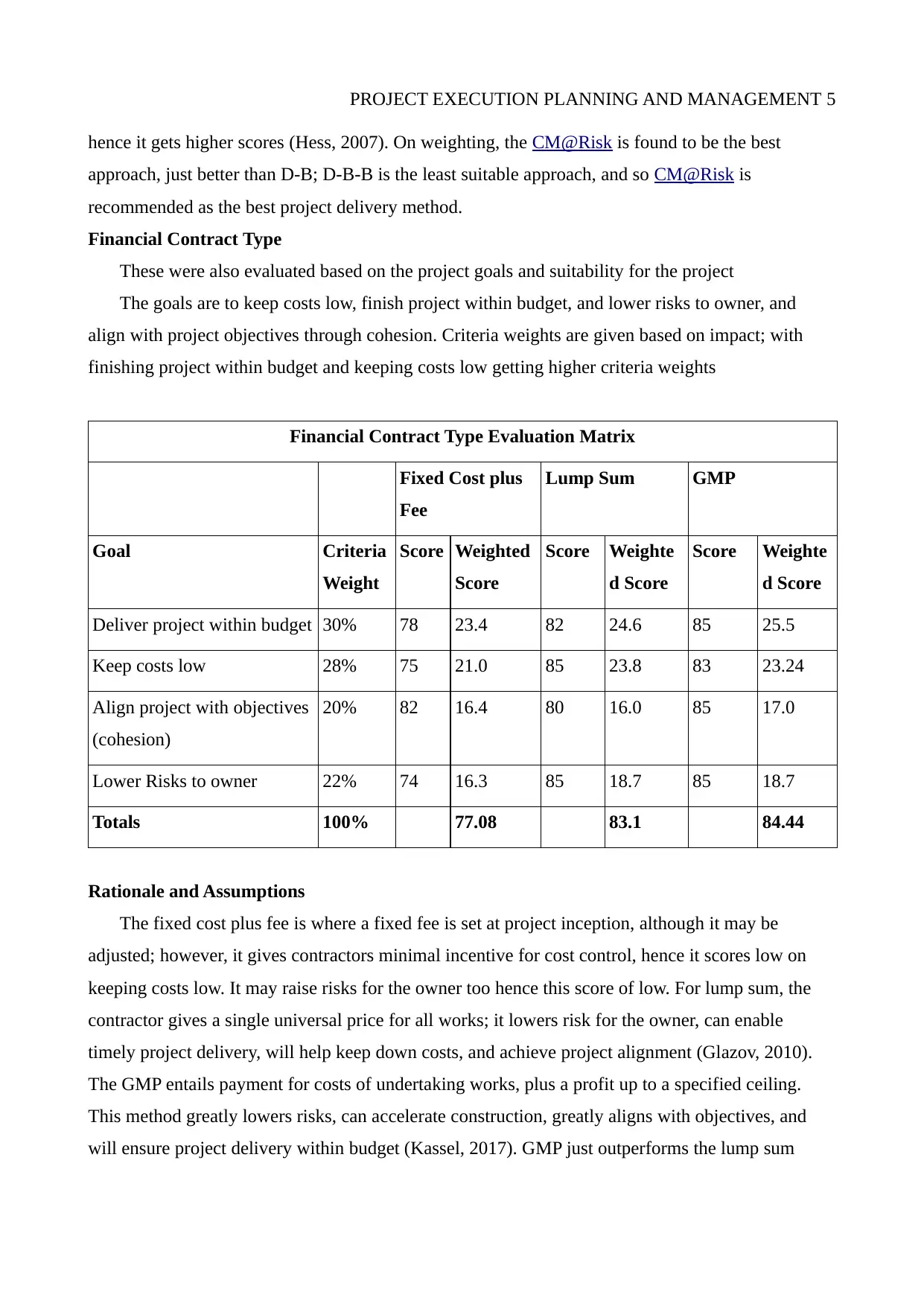
PROJECT EXECUTION PLANNING AND MANAGEMENT 5
hence it gets higher scores (Hess, 2007). On weighting, the CM@Risk is found to be the best
approach, just better than D-B; D-B-B is the least suitable approach, and so CM@Risk is
recommended as the best project delivery method.
Financial Contract Type
These were also evaluated based on the project goals and suitability for the project
The goals are to keep costs low, finish project within budget, and lower risks to owner, and
align with project objectives through cohesion. Criteria weights are given based on impact; with
finishing project within budget and keeping costs low getting higher criteria weights
Financial Contract Type Evaluation Matrix
Fixed Cost plus
Fee
Lump Sum GMP
Goal Criteria
Weight
Score Weighted
Score
Score Weighte
d Score
Score Weighte
d Score
Deliver project within budget 30% 78 23.4 82 24.6 85 25.5
Keep costs low 28% 75 21.0 85 23.8 83 23.24
Align project with objectives
(cohesion)
20% 82 16.4 80 16.0 85 17.0
Lower Risks to owner 22% 74 16.3 85 18.7 85 18.7
Totals 100% 77.08 83.1 84.44
Rationale and Assumptions
The fixed cost plus fee is where a fixed fee is set at project inception, although it may be
adjusted; however, it gives contractors minimal incentive for cost control, hence it scores low on
keeping costs low. It may raise risks for the owner too hence this score of low. For lump sum, the
contractor gives a single universal price for all works; it lowers risk for the owner, can enable
timely project delivery, will help keep down costs, and achieve project alignment (Glazov, 2010).
The GMP entails payment for costs of undertaking works, plus a profit up to a specified ceiling.
This method greatly lowers risks, can accelerate construction, greatly aligns with objectives, and
will ensure project delivery within budget (Kassel, 2017). GMP just outperforms the lump sum
hence it gets higher scores (Hess, 2007). On weighting, the CM@Risk is found to be the best
approach, just better than D-B; D-B-B is the least suitable approach, and so CM@Risk is
recommended as the best project delivery method.
Financial Contract Type
These were also evaluated based on the project goals and suitability for the project
The goals are to keep costs low, finish project within budget, and lower risks to owner, and
align with project objectives through cohesion. Criteria weights are given based on impact; with
finishing project within budget and keeping costs low getting higher criteria weights
Financial Contract Type Evaluation Matrix
Fixed Cost plus
Fee
Lump Sum GMP
Goal Criteria
Weight
Score Weighted
Score
Score Weighte
d Score
Score Weighte
d Score
Deliver project within budget 30% 78 23.4 82 24.6 85 25.5
Keep costs low 28% 75 21.0 85 23.8 83 23.24
Align project with objectives
(cohesion)
20% 82 16.4 80 16.0 85 17.0
Lower Risks to owner 22% 74 16.3 85 18.7 85 18.7
Totals 100% 77.08 83.1 84.44
Rationale and Assumptions
The fixed cost plus fee is where a fixed fee is set at project inception, although it may be
adjusted; however, it gives contractors minimal incentive for cost control, hence it scores low on
keeping costs low. It may raise risks for the owner too hence this score of low. For lump sum, the
contractor gives a single universal price for all works; it lowers risk for the owner, can enable
timely project delivery, will help keep down costs, and achieve project alignment (Glazov, 2010).
The GMP entails payment for costs of undertaking works, plus a profit up to a specified ceiling.
This method greatly lowers risks, can accelerate construction, greatly aligns with objectives, and
will ensure project delivery within budget (Kassel, 2017). GMP just outperforms the lump sum
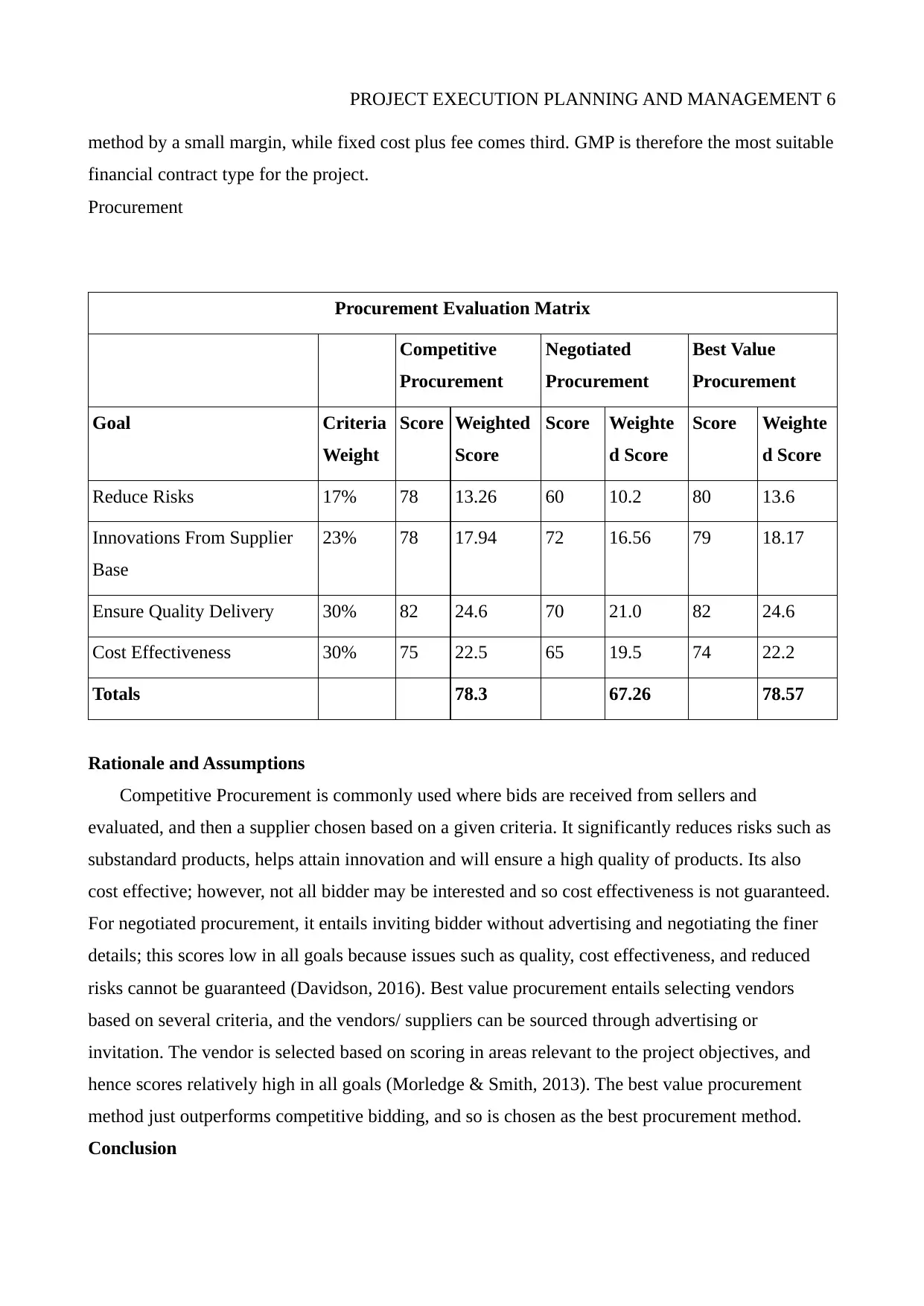
PROJECT EXECUTION PLANNING AND MANAGEMENT 6
method by a small margin, while fixed cost plus fee comes third. GMP is therefore the most suitable
financial contract type for the project.
Procurement
Procurement Evaluation Matrix
Competitive
Procurement
Negotiated
Procurement
Best Value
Procurement
Goal Criteria
Weight
Score Weighted
Score
Score Weighte
d Score
Score Weighte
d Score
Reduce Risks 17% 78 13.26 60 10.2 80 13.6
Innovations From Supplier
Base
23% 78 17.94 72 16.56 79 18.17
Ensure Quality Delivery 30% 82 24.6 70 21.0 82 24.6
Cost Effectiveness 30% 75 22.5 65 19.5 74 22.2
Totals 78.3 67.26 78.57
Rationale and Assumptions
Competitive Procurement is commonly used where bids are received from sellers and
evaluated, and then a supplier chosen based on a given criteria. It significantly reduces risks such as
substandard products, helps attain innovation and will ensure a high quality of products. Its also
cost effective; however, not all bidder may be interested and so cost effectiveness is not guaranteed.
For negotiated procurement, it entails inviting bidder without advertising and negotiating the finer
details; this scores low in all goals because issues such as quality, cost effectiveness, and reduced
risks cannot be guaranteed (Davidson, 2016). Best value procurement entails selecting vendors
based on several criteria, and the vendors/ suppliers can be sourced through advertising or
invitation. The vendor is selected based on scoring in areas relevant to the project objectives, and
hence scores relatively high in all goals (Morledge & Smith, 2013). The best value procurement
method just outperforms competitive bidding, and so is chosen as the best procurement method.
Conclusion
method by a small margin, while fixed cost plus fee comes third. GMP is therefore the most suitable
financial contract type for the project.
Procurement
Procurement Evaluation Matrix
Competitive
Procurement
Negotiated
Procurement
Best Value
Procurement
Goal Criteria
Weight
Score Weighted
Score
Score Weighte
d Score
Score Weighte
d Score
Reduce Risks 17% 78 13.26 60 10.2 80 13.6
Innovations From Supplier
Base
23% 78 17.94 72 16.56 79 18.17
Ensure Quality Delivery 30% 82 24.6 70 21.0 82 24.6
Cost Effectiveness 30% 75 22.5 65 19.5 74 22.2
Totals 78.3 67.26 78.57
Rationale and Assumptions
Competitive Procurement is commonly used where bids are received from sellers and
evaluated, and then a supplier chosen based on a given criteria. It significantly reduces risks such as
substandard products, helps attain innovation and will ensure a high quality of products. Its also
cost effective; however, not all bidder may be interested and so cost effectiveness is not guaranteed.
For negotiated procurement, it entails inviting bidder without advertising and negotiating the finer
details; this scores low in all goals because issues such as quality, cost effectiveness, and reduced
risks cannot be guaranteed (Davidson, 2016). Best value procurement entails selecting vendors
based on several criteria, and the vendors/ suppliers can be sourced through advertising or
invitation. The vendor is selected based on scoring in areas relevant to the project objectives, and
hence scores relatively high in all goals (Morledge & Smith, 2013). The best value procurement
method just outperforms competitive bidding, and so is chosen as the best procurement method.
Conclusion
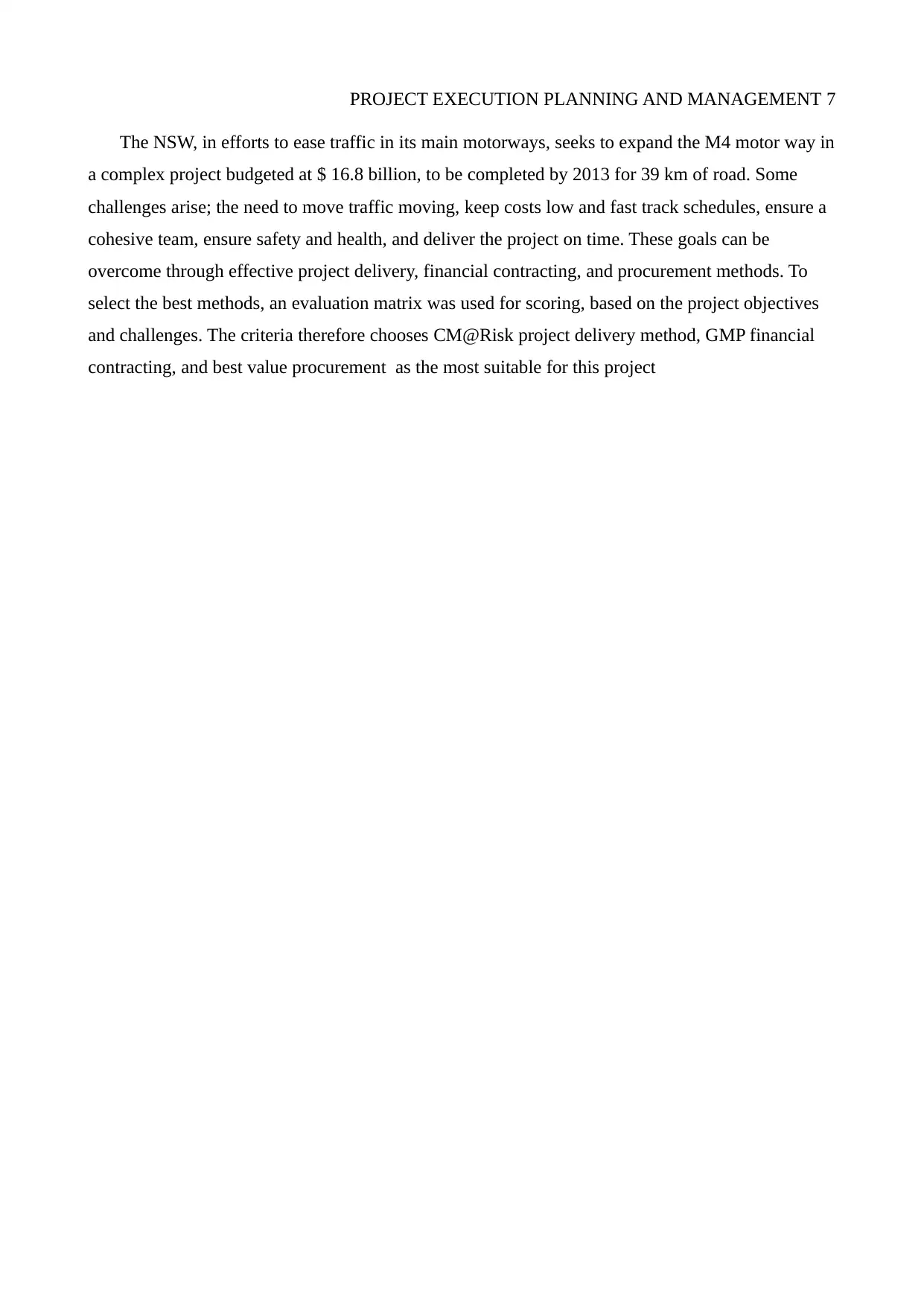
PROJECT EXECUTION PLANNING AND MANAGEMENT 7
The NSW, in efforts to ease traffic in its main motorways, seeks to expand the M4 motor way in
a complex project budgeted at $ 16.8 billion, to be completed by 2013 for 39 km of road. Some
challenges arise; the need to move traffic moving, keep costs low and fast track schedules, ensure a
cohesive team, ensure safety and health, and deliver the project on time. These goals can be
overcome through effective project delivery, financial contracting, and procurement methods. To
select the best methods, an evaluation matrix was used for scoring, based on the project objectives
and challenges. The criteria therefore chooses CM@Risk project delivery method, GMP financial
contracting, and best value procurement as the most suitable for this project
The NSW, in efforts to ease traffic in its main motorways, seeks to expand the M4 motor way in
a complex project budgeted at $ 16.8 billion, to be completed by 2013 for 39 km of road. Some
challenges arise; the need to move traffic moving, keep costs low and fast track schedules, ensure a
cohesive team, ensure safety and health, and deliver the project on time. These goals can be
overcome through effective project delivery, financial contracting, and procurement methods. To
select the best methods, an evaluation matrix was used for scoring, based on the project objectives
and challenges. The criteria therefore chooses CM@Risk project delivery method, GMP financial
contracting, and best value procurement as the most suitable for this project
Paraphrase This Document
Need a fresh take? Get an instant paraphrase of this document with our AI Paraphraser
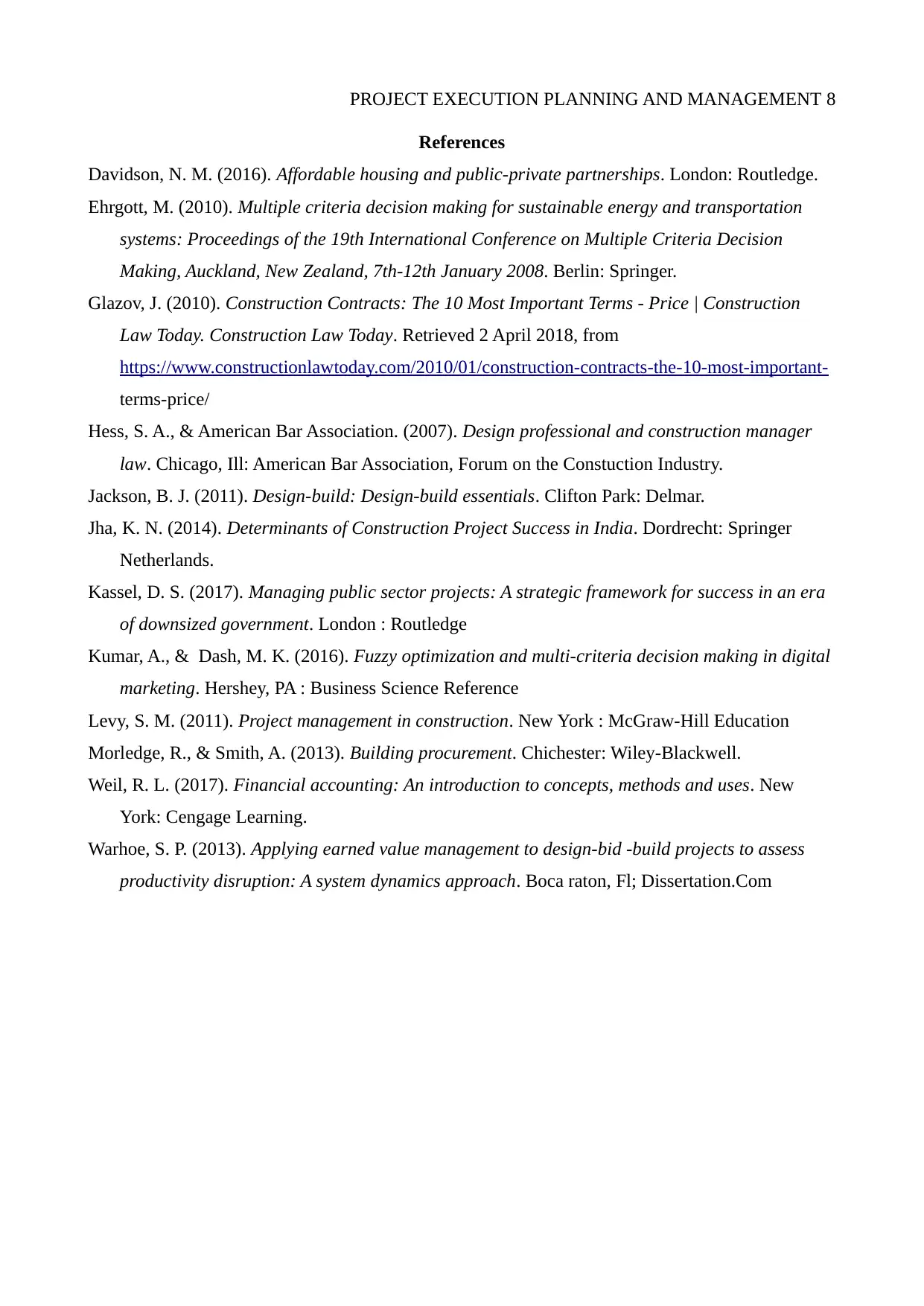
PROJECT EXECUTION PLANNING AND MANAGEMENT 8
References
Davidson, N. M. (2016). Affordable housing and public-private partnerships. London: Routledge.
Ehrgott, M. (2010). Multiple criteria decision making for sustainable energy and transportation
systems: Proceedings of the 19th International Conference on Multiple Criteria Decision
Making, Auckland, New Zealand, 7th-12th January 2008. Berlin: Springer.
Glazov, J. (2010). Construction Contracts: The 10 Most Important Terms - Price | Construction
Law Today. Construction Law Today. Retrieved 2 April 2018, from
https://www.constructionlawtoday.com/2010/01/construction-contracts-the-10-most-important-
terms-price/
Hess, S. A., & American Bar Association. (2007). Design professional and construction manager
law. Chicago, Ill: American Bar Association, Forum on the Constuction Industry.
Jackson, B. J. (2011). Design-build: Design-build essentials. Clifton Park: Delmar.
Jha, K. N. (2014). Determinants of Construction Project Success in India. Dordrecht: Springer
Netherlands.
Kassel, D. S. (2017). Managing public sector projects: A strategic framework for success in an era
of downsized government. London : Routledge
Kumar, A., & Dash, M. K. (2016). Fuzzy optimization and multi-criteria decision making in digital
marketing. Hershey, PA : Business Science Reference
Levy, S. M. (2011). Project management in construction. New York : McGraw-Hill Education
Morledge, R., & Smith, A. (2013). Building procurement. Chichester: Wiley-Blackwell.
Weil, R. L. (2017). Financial accounting: An introduction to concepts, methods and uses. New
York: Cengage Learning.
Warhoe, S. P. (2013). Applying earned value management to design-bid -build projects to assess
productivity disruption: A system dynamics approach. Boca raton, Fl; Dissertation.Com
References
Davidson, N. M. (2016). Affordable housing and public-private partnerships. London: Routledge.
Ehrgott, M. (2010). Multiple criteria decision making for sustainable energy and transportation
systems: Proceedings of the 19th International Conference on Multiple Criteria Decision
Making, Auckland, New Zealand, 7th-12th January 2008. Berlin: Springer.
Glazov, J. (2010). Construction Contracts: The 10 Most Important Terms - Price | Construction
Law Today. Construction Law Today. Retrieved 2 April 2018, from
https://www.constructionlawtoday.com/2010/01/construction-contracts-the-10-most-important-
terms-price/
Hess, S. A., & American Bar Association. (2007). Design professional and construction manager
law. Chicago, Ill: American Bar Association, Forum on the Constuction Industry.
Jackson, B. J. (2011). Design-build: Design-build essentials. Clifton Park: Delmar.
Jha, K. N. (2014). Determinants of Construction Project Success in India. Dordrecht: Springer
Netherlands.
Kassel, D. S. (2017). Managing public sector projects: A strategic framework for success in an era
of downsized government. London : Routledge
Kumar, A., & Dash, M. K. (2016). Fuzzy optimization and multi-criteria decision making in digital
marketing. Hershey, PA : Business Science Reference
Levy, S. M. (2011). Project management in construction. New York : McGraw-Hill Education
Morledge, R., & Smith, A. (2013). Building procurement. Chichester: Wiley-Blackwell.
Weil, R. L. (2017). Financial accounting: An introduction to concepts, methods and uses. New
York: Cengage Learning.
Warhoe, S. P. (2013). Applying earned value management to design-bid -build projects to assess
productivity disruption: A system dynamics approach. Boca raton, Fl; Dissertation.Com
1 out of 8
Related Documents
Your All-in-One AI-Powered Toolkit for Academic Success.
+13062052269
info@desklib.com
Available 24*7 on WhatsApp / Email
![[object Object]](/_next/static/media/star-bottom.7253800d.svg)
Unlock your academic potential
© 2024 | Zucol Services PVT LTD | All rights reserved.



